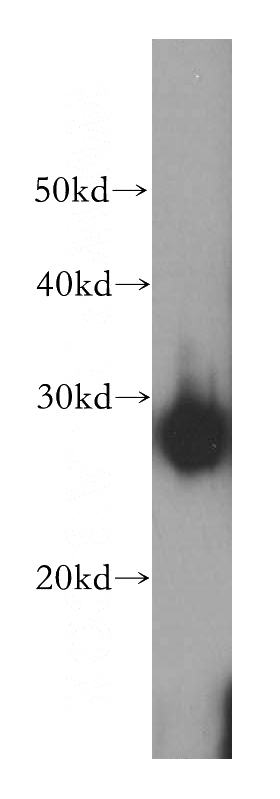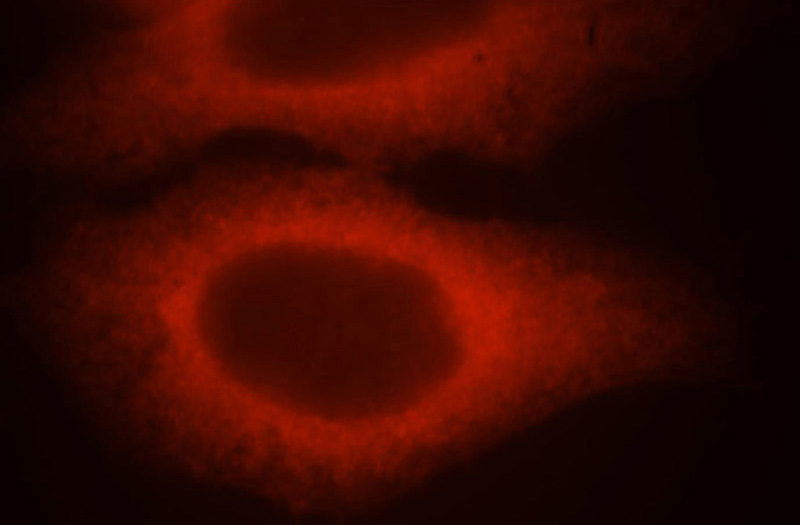-
Product Name
HSP27 antibody
- Documents
-
Description
HSP27 Rabbit Polyclonal antibody. Positive WB detected in HeLa cells, human skeletal muscle tissue, human stomach tissue, MCF7 cells. Positive IF detected in MCF-7 cells, Hela cells. Observed molecular weight by Western-blot: 27 kDa
-
Tested applications
ELISA, WB, IF
-
Species reactivity
Human; other species not tested.
-
Alternative names
Heat shOCk protein beta 1 antibody; HSP 27 antibody; Hsp25 antibody; HSP27 antibody; HSP28 antibody; HSPB1 antibody
-
Isotype
Rabbit IgG
-
Preparation
This antibody was obtained by immunization of HSP27 recombinant protein (Accession Number: NM_001540). Purification method: Antigen affinity purified.
-
Clonality
Polyclonal
-
Formulation
PBS with 0.02% sodium azide and 50% glycerol pH 7.3.
-
Storage instructions
Store at -20℃. DO NOT ALIQUOT
-
Applications
Recommended Dilution:
WB: 1:500-1:5000
IF: 1:10-1:100
-
Validations

HeLa cells were subjected to SDS PAGE followed by western blot with Catalog No:111565(HSPB1 antibody) at dilution of 1:500

Immunofluorescent analysis of MCF-7 cells, using HSPB1 antibody Catalog No:111565 at 1:25 dilution and Rhodamine-labeled goat anti-rabbit IgG (red).
-
Background
HSPB1, also known as heat shock protein 27 (Hsp27), belongs to the small heat shock protein family which is induced in response to environmental challenges or/and developmental transitions. It is also an anti-apoptotic protein that plays crucial roles in tumorigenesis and cell survival and is reported to be an independent prognosis marker for cancer. Recently HSPB1 has been found to be a valuable marker for melanoma.
-
References
- Su TR, Lin JJ, Chiu CC. Proteomic investigation of anti-tumor activities exerted by sinularin against A2058 melanoma cells. Electrophoresis. 33(7):1139-52. 2012.
- Ho KY, Yeh TS, Huang HH. Upregulation of phosphorylated HSP27, PRDX2, GRP75, GRP78 and GRP94 in acquired middle ear cholesteatoma growth. International journal of molecular sciences. 14(7):14439-59. 2013.
- Li HH, Su JH, Chiu CC. Proteomic investigation of the sinulariolide-treated melanoma cells A375: effects on the cell apoptosis through mitochondrial-related pathway and activation of caspase cascade. Marine drugs. 11(7):2625-42. 2013.
- Cabrera S, Fernández AF, Mariño G. ATG4B/autophagin-1 regulates intestinal homeostasis and protects mice from experimental colitis. Autophagy. 9(8):1188-200. 2013.
- Kötter S, Unger A, Hamdani N. Human myocytes are protected from titin aggregation-induced stiffening by small heat shock proteins. The Journal of cell biology. 204(2):187-202. 2014.
- Yang L, Wang Y, Zhang Q. Identification of Hsf1 as a novel androgen receptor-regulated gene in mouse Sertoli cells. Molecular reproduction and development. 81(6):514-23. 2014.
- Chen P, Shi L, Jiang Y. Identification of heat shock protein 27 as a novel autoantigen of Behçet's disease. Biochemical and biophysical research communications. 456(4):866-71. 2015.
- Zeng S, Zhang H, Ding Z. Proteome analysis of porcine epidemic diarrhea virus (PEDV)-infected Vero cells. Proteomics. 15(11):1819-28. 2015.
Related Products / Services
Please note: All products are "FOR RESEARCH USE ONLY AND ARE NOT INTENDED FOR DIAGNOSTIC OR THERAPEUTIC USE"
